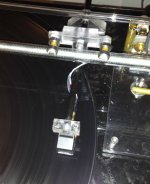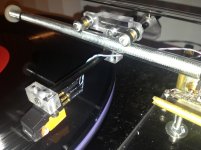Thank you, Colin. But I think it is a big difference.
I've been pouring thru the other thread but haven't come across numbers yet. Anyhow if a cart is mounted at 13mm+/_ . Cantus appears 30mm+/_, at double width. And yours at triple the width. Yours in the horz. would be more stable but, would this come into play or not. At first thought, I wouldn't believe so. But on warped records with all the hem and haw...
I've been pouring thru the other thread but haven't come across numbers yet. Anyhow if a cart is mounted at 13mm+/_ . Cantus appears 30mm+/_, at double width. And yours at triple the width. Yours in the horz. would be more stable but, would this come into play or not. At first thought, I wouldn't believe so. But on warped records with all the hem and haw...
Golana,
My arm is very stable in both the horizontal and vertical plane, spacing was decided after lots of experimentation. I've noticed the clearaudio tt3 also has wider bearing spacing for being essentially a cantus copy.
Colin
My arm is very stable in both the horizontal and vertical plane, spacing was decided after lots of experimentation. I've noticed the clearaudio tt3 also has wider bearing spacing for being essentially a cantus copy.
Colin
Ralf,
Souther was first if I recall right. That became the Clearaudio tt1 after they bought the rights, the tt3 and tt2 came long after the cantus which use the same concept.
Colin
Souther was first if I recall right. That became the Clearaudio tt1 after they bought the rights, the tt3 and tt2 came long after the cantus which use the same concept.
Colin
Souther was first.. it actually was released in the middle of the 80's. Made by Lou Souther.
Clearaudio bought up the right's to the design and "improved" it, and named it TQi - actually at first they made it worse with to tick tonearm wire (hard to get the stylus pressure right, and it was stiff when moving sidewards), but with a better mounting. And later they improved the VTA-adjustment, better bearings and so on, and also released ultra-expensive "Master TQi"
The Clearaudio cantus-clone was first released as their state of the art tonearm TT1 was released.. this is the tonearm on the "Statement" turntable. But on TT1 the bearings is under the arm, that means the glass tube is closer to the same level as the cartridge.
And a few years later TQi (and Master TQi) was replaced with TT3 and TT2 arms.
Myself i actually have an old TQi (first clearaudio version) that i have upgraded with TT3 glasstube, carriage and carbon arm. Wasn't really THAT expensive, and i like the adjustment possiblitites with the TQi "base".
I think that Bo Hansson have gotten way to little acknowledgement for his design, and it's great to see it does at least get it here.
Clearaudio bought up the right's to the design and "improved" it, and named it TQi - actually at first they made it worse with to tick tonearm wire (hard to get the stylus pressure right, and it was stiff when moving sidewards), but with a better mounting. And later they improved the VTA-adjustment, better bearings and so on, and also released ultra-expensive "Master TQi"
The Clearaudio cantus-clone was first released as their state of the art tonearm TT1 was released.. this is the tonearm on the "Statement" turntable. But on TT1 the bearings is under the arm, that means the glass tube is closer to the same level as the cartridge.
And a few years later TQi (and Master TQi) was replaced with TT3 and TT2 arms.
Myself i actually have an old TQi (first clearaudio version) that i have upgraded with TT3 glasstube, carriage and carbon arm. Wasn't really THAT expensive, and i like the adjustment possiblitites with the TQi "base".
I think that Bo Hansson have gotten way to little acknowledgement for his design, and it's great to see it does at least get it here.
Last edited:
Bo was the first euro importer of Souther
Bo liked Lou's arm but felt that it had weaknesses he and Lou used to discuss design. Bo designed the Cantus as a response to his conerns over the faults he felt existed in the Souther arm. Souther later sold to ClearAudio and continued to design through them. Bo's last major change to the Cantus was to eliminate the flange on the bearings which was there to allow the arm to rock as if on a knife edge. The current version has nor flange and this make the arm more rigid and as Bo put it "there is greater conversion of energy from the stylus tip into electrical signal this way" Bo felt that the more free range of motion the arm has the more loss there will be. Best regards Moray James.
Ralf,
Souther was first if I recall right. That became the Clearaudio tt1 after they bought the rights, the tt3 and tt2 came long after the Cantus which use the same concept.
Colin
Bo liked Lou's arm but felt that it had weaknesses he and Lou used to discuss design. Bo designed the Cantus as a response to his conerns over the faults he felt existed in the Souther arm. Souther later sold to ClearAudio and continued to design through them. Bo's last major change to the Cantus was to eliminate the flange on the bearings which was there to allow the arm to rock as if on a knife edge. The current version has nor flange and this make the arm more rigid and as Bo put it "there is greater conversion of energy from the stylus tip into electrical signal this way" Bo felt that the more free range of motion the arm has the more loss there will be. Best regards Moray James.
Heard the Clearaudio top TT today with the linear tracker and Goldfinger cartridge, must say a was wildly impressed. last time i hear the Goldfinger was also on at linear tracking tone arm (the walker) It has a unique solid form of presentation i really like. but as the two times i have hear the goldfing it has been on a linear tracker, so maybe it's the absence of tracking angle error i hear (or don't hear)
Thanks to all you Gentlemen who responded to my question concerning the Souther and Cantus tone arms.
Sincerely,
Ralf
Sincerely,
Ralf
MiiB,
You wouldn't think the relatively minor tracking error would cause that much difference but it does, I've had first hand experience with this. Even these minor errors are audible on this format, not offensive, but audible and once you enter zero tracking error the difference in imaging and presentation is instantly noted. I think the mechanical arms too have the advantage of mechanical coupling vs the air bearing arms which must find ways to deal with resonance that can't escape the arm through various means. The only disadvantage with mechanical is that you simply can't make the arm too long, things get heavy quick and of course the physics are self explanatory 🙂.
Colin
You wouldn't think the relatively minor tracking error would cause that much difference but it does, I've had first hand experience with this. Even these minor errors are audible on this format, not offensive, but audible and once you enter zero tracking error the difference in imaging and presentation is instantly noted. I think the mechanical arms too have the advantage of mechanical coupling vs the air bearing arms which must find ways to deal with resonance that can't escape the arm through various means. The only disadvantage with mechanical is that you simply can't make the arm too long, things get heavy quick and of course the physics are self explanatory 🙂.
Colin
Thanks for the drawing vynuhl addict. It shows what I thought you meant but in some of the earlier post it actually sounded like you had shim between the inner race and the shaft is was mounted on. This is what caused me difficulty but now I see it all straight forward.
jamikl
jamikl
difference in sound
Hi Colin,
How does the single rod to the headshell in the latest carriage sound compared to the previous one with the two small rods?
Regards,
Wayne
Hi Colin,
How does the single rod to the headshell in the latest carriage sound compared to the previous one with the two small rods?
Regards,
Wayne
Colin: that does look more like the clearaudio carriage, and i take it you have a screw at the top to secure the Azimuth setting?
There is a set screw at the bottom to secure azimuth. Also the counterweight is mounted on the single tube wand, funny as hanging all the mass below the bearings seems to allow more mass without affecting the cantilever. Sound?, so far with headphones it has taken another series of steps up, quiet surfaces, dynamic contrast and lucidity seems to have an edge ovr the two wands. I have used .220" carbon fiber tube here. I do love the look of the Clearaudio arms!.
Colin
Colin
RollE2K,
Thank you, not sure of the total mass at this point but must be atleast 25g based on prior knowledge. The increased polycarbonate mass that holds the bearings and wand seems to be of benefit. Perhaps of benefit too is the partial decoupling of the wand with a set screw, but the azimuth adjustment and ability to interchange wands is a plus, after all its about rigidity and the single thicker tube is as rigid as the two tubes, but much easier to build. I've also moved the bearings from 43.75mm to a 39-40mm spacing.
Colin
Thank you, not sure of the total mass at this point but must be atleast 25g based on prior knowledge. The increased polycarbonate mass that holds the bearings and wand seems to be of benefit. Perhaps of benefit too is the partial decoupling of the wand with a set screw, but the azimuth adjustment and ability to interchange wands is a plus, after all its about rigidity and the single thicker tube is as rigid as the two tubes, but much easier to build. I've also moved the bearings from 43.75mm to a 39-40mm spacing.
Colin
Well, I'll be damned. Despite my initial skepticism, I believe Colin's got something here.
Anybody else built one?
Anybody else built one?
Attachments
Last edited:
Will two intentionally undersized U-grooved bearing work, instead four flat bearings? Two undersized U-grooved bearings on a rod will represent as four contact points just like Colin's arm but reduces mass and less ball chattering perhaps?


Last edited:
- Home
- Source & Line
- Analogue Source
- DIY linear tonearm


